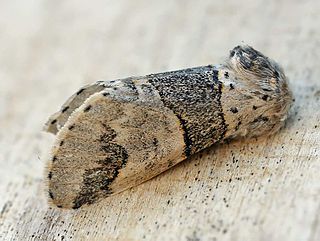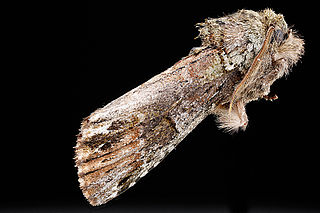
The Noctuidae, commonly known as owlet moths, cutworms or armyworms, are a family of moths. They are considered the most controversial family in the superfamily Noctuoidea because many of the clades are constantly changing, along with the other families of the Noctuoidea. It was considered the largest family in Lepidoptera for a long time, but after regrouping Lymantriinae, Catocalinae and Calpinae within the family Erebidae, the latter holds this title now. Currently, Noctuidae is the second largest family in Noctuoidea, with about 1,089 genera and 11,772 species. This classification is still contingent, as more changes continue to appear between Noctuidae and Erebidae.

The geometer moths are moths belonging to the family Geometridae of the insect order Lepidoptera, the moths and butterflies. Their scientific name derives from the Ancient Greek geo γεω, and metron μέτρον "measure" in reference to the way their larvae, or inchworms, appear to measure the earth as they move along in a looping fashion. A very large family, it has around 23,000 species of moths described, and over 1400 species from six subfamilies indigenous to North America alone. A well-known member is the peppered moth, Biston betularia, which has been subject of numerous studies in population genetics. Several other geometer moths are notorious pests.

The Arctiinae are a large and diverse subfamily of moths with around 11,000 species found all over the world, including 6,000 neotropical species. This subfamily includes the groups commonly known as tiger moths, which usually have bright colours, footmen, which are usually much drabber, lichen moths, and wasp moths. Many species have "hairy" caterpillars that are popularly known as woolly bears or woolly worms. The scientific name Arctiinae refers to this hairiness. Some species within the Arctiinae have the word "tussock"' in their common names because they have been misidentified as members of the Lymantriinae subfamily based on the characteristics of the larvae.

The pine processionary is a moth of the subfamily Thaumetopoeinae in the family Notodontidae, known for the irritating hairs of its caterpillars, their processions, and the economic damage they cause in coniferous forests. The species was first described scientifically by Michael Denis and Ignaz Schiffermüller in 1775, though it was known to the ancients, with remedies described by Theophrastus, Dioscorides and Pliny the Elder. Its processionary behaviour was described in 1916 by the French entomologist Jean-Henri Fabre. It is one of the most destructive species to pines and cedars in Central Asia, North Africa and southern Europe.

The poplar kitten is a species of moth in the family Notodontidae. The species was first described by Nikolaus Joseph Brahm in 1787. They are found throughout Europe and in North Africa, Mongolia, Kazakhstan and Xinjiang.

Cerura vinula, the puss moth, is a lepidopteran from the family Notodontidae. The species was first described by Carl Linnaeus in his 1758 10th edition of Systema Naturae.

Cerura erminea is a moth of the family Notodontidae, also known as the lesser puss moth or feline. It is found in Europe.

Ochrogaster lunifer, the bag-shelter moth or processionary caterpillar, is a member of the family Notodontidae. The species was first described by Gottlieb August Wilhelm Herrich-Schäffer in 1855. Both the larval and adult forms have hairs that cause irritation of the skin (urticaria). The adult moth has a woolly appearance and its wings can grow to be about 5.5 cm across. The larvae feed on Grevillea striata at night and reside in brown silken bag nest during the day.

Datana major, the major datana or azalea caterpillar, is a moth of the family Notodontidae. It is found from Maryland to Florida, west to Kansas and Arkansas.

Coelodasys unicornis, the unicorn caterpillar moth, unicorn prominent or variegated prominent, is a species of moth in the family Notodontidae. It was first described by James Edward Smith in 1797 and is found in North America south of the Arctic.
Erbessa pales is a moth of the family Notodontidae first described by Herbert Druce in 1893. It is found in Ecuador, Brazil, Peru and Bolivia.
Erbessa pyraloides is a moth of the family Notodontidae first described by Francis Walker in 1854. It is found in Brazil, Colombia and Venezuela.
Erbessa sobria is a moth of the family Notodontidae first described by Francis Walker in 1854. It is found in Brazil, Ecuador, Colombia, Venezuela and Guyana.
Erbessa tegyroides is a moth of the family Notodontidae first described by James S. Miller in 2008. It is found in south-eastern Peru.
Phryganidia naxa is a moth of the family Notodontidae first described by Herbert Druce in 1887. It is found in Guatemala and Mexico.
Phanoptis cyanomelas is a moth of the family Notodontidae first described by Cajetan and Rudolf Felder in 1874. It is found in Costa Rica, Panama, Colombia and Ecuador.
Polypoetes approximans is a moth of the family Notodontidae. It is found from Panama north to Costa Rica.
Polypoetes copiosa is a moth of the family Notodontidae. It has a restricted distribution along the foothills of the Andes in western Ecuador.
Chrysoglossa demades is a moth of the family Notodontidae first described by Herbert Druce in 1885. It is found in Panama, Costa Rica, Nicaragua and Mexico.
Chrysoglossa norburyi is a moth of the family Notodontidae first described by James S. Miller in 2008. It is found in Costa Rica.











